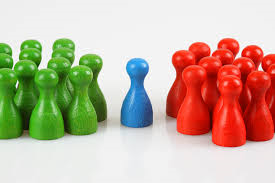Social Injustice: Discrimination
Apr 14,2016
Social Injustice: Discrimination
Social injustice can be described as a situation in which dominant population is made known of the inequity that leads for others due to their relative position in the structure of power (Maus n.p.). Social injustice is also the way unjust actions are done in the society. Social injustice occurs in a situation where the equals are treated unequally and the unequal is treated equally. Three common examples of social injustice include: discrimination, ageism, and homophobia (Farooq n.p.). I want to focus on discrimination, its causes, and the solutions of discrimination.
Discrimination is found in education, housing, employment, voting, lending and credit, land use, health care services, transportation, public accommodations, and government benefits and services (Find Law n.p.). Discrimination is described as unequal treatment of persons, for a reason which has nothing to do with legal rights or ability. Discrimination is considered illegal by the federal and state laws of the United States of America. These laws prohibit discrimination in employment, availability of housing, rates of pay, right to promotion, educational opportunity, civil rights, and use of facilities based on race, nationality, creed, color, age, sex, or sexual orientation (K. Hill and G. Hill n.p.). Discrimination always promotes or reveals unfair treatment of a person or a particular group of people on the basis of prejudice and partiality which could lead to emotions such as frustration and anger. Discrimination seen or considered as a mild or serious form of suffering, with anger sometimes, in particular, if applicable, anger at the person or persons who caused it. (U.K. Essay n.p.). This is why discrimination is considered or seen as a social injustice issue in our society today.
A census data was conducted by the researchers at Brown University which found that income is not the only driving factor in the separation of races or ethnic groups in U.S. cities. Minority groups at every income level live in poorer neighborhoods than do whites with comparable incomes. White people have the advantage or better chances of living in better neighborhoods than people from other races. The study also shows that there are fewer resources for those in minority neighborhoods (Goyette and Scheller n.p.). Another study done in the state of Arizona shows during the years of 2006 to 2007, the state highway patrol was more likely to stop African Americans and Hispanic drivers than white drivers on all the highways that were studied. Native Americans and people of Middle Eastern descent were more likely to be stopped on most of all the highways studied. The highway patrol was 3.5 times more likely to search a Native American than a white individual, and 2.5 times more likely to search a stopped African American or Hispanic driver (The Leadership Conference on Civil and Human Rights n.p.).
The Injustice at Every Turn survey revealed that twenty-five percent of transgender recipients reported losing a job because they did not conform to gender norms. A staggering ninety percent said they faced some forms of transgender-based discrimination. In 2008, a survey by the Injustice at Every Turn also showed that the amount of unemployed transgender respondent was two times the rate of the entire population used and they were more likely to get a wage of less than ten thousand dollars compared to the rest of the population in the survey conducted (Paquette n.p.). The Equal Employment Opportunity Commission (EEOC) fielded 16,008 charges of age discrimination in 2000 and 23,264 in 2010, which was more than forty-five percent increase. The EEOC helped obtain settlements of $45.2 million in 2000 and $93.6 million in 2010, which was more than a hundred percent increase. Numbers of legation trended in the same ways and resulted in far greater costs to business, both in fees and damages paid (Smith Moore Leatherwood n.p.).
Stereotypes is a cause of discrimination, because one might not think about the stereotypes or prejudices a person holds might hurt or put other people to disadvantage without the person realizing or knowing. People, sometimes, think that they are simply behaving in ways that actually reflect the realities or abilities of a group men and women, rather they are actually discriminating and promoting inequality in the society. A stereotype is seems positive, the fact that not all persons in that group always meets the standard that often leads to a positive stereotype, which disadvantages individuals in that group (Gender Equality n.p.). Greenwald and Pettigrew reviewed experiments and survey methods from published scientific research on discrimination from the last five decades. They found that the discrimination observed in those studies occurred much more often as helping rather than harming someone. They also found that most researchers defined discrimination as based on negative attitudes and hostility, only rarely treating favoritism as a component of discrimination (Armstrong n.p.).
Discrimination is not caused by what happens outside of us. It is caused by seeing things wrongly, what is said to from one to another, commonly referred to as self-talk, and also thoughts or beliefs. When one talks his or herself into becoming anxious, annoyed or angry, because they don't know something or lack understanding about some thing or someone else, or are scared. Quickly, it leads one into a mind-set of discrimination or prejudice (Griffith n.p.). Discrimination is also promoted by patriarchal cultural beliefs. These beliefs usually encourage discrimination by thinking of male gender to be of greater importance than that of females. These beliefs tense describes men with more positive attributes, like being stronger or smarter. Usually men occupy the higher positions and have power to decide the amount of access women have to opportunities, from education and playing sports, to participating in politics and making independent choices about their personal lives (Kidder n.p.).
One way to treat discrimination is to have government intervention discrimination, because federal laws of the United States prohibit discrimination based on a person's country of origin, race, color, religion, disability, sex, and familial status. Laws prohibiting national origin discrimination deem discrimination or discriminatory acts illegal because of a person's birthplace, ancestry, culture or language (The United States Department of Justice n.p.). The state government also has the power to make laws prohibiting people from discriminatory acts. Many states enacted laws that ban any and all forms of discrimination. Specifically, six states have passed ballot initiatives in order to amend their constitutions and prohibit state and local governments from portraying discrimination in public, contract making, and educational aspects on the basis of race, ethnicity, or sex. These states include California in 1996, Washington in 1998, Michigan in 2006, Nebraska in 2008, Arizona in 2010, and Oklahoma in 2012 (Clegg and von Spavosky n.p.).
Another way to eradicate discrimination is to promote diversity in our society. Diversity was introduced as a kind of end run around the historical problem of racism, the commitment to diversity is associated with the struggle against racism. The objective of eradication or treating racism is to create a color-blind society rather and having a color-conscious society. Instead of treating people as if their race does not matter, we should not only recognize but celebrate racial identity (Michaels). Cultural diversity is important, because workplaces, and schools increasingly consist of various cultural, racial, and ethnic groups which we could learn from. Learning about other cultures helps understand different perspectives within the world in which we find ourselves in, dispelling negative stereotypes and personal biases about different groups or ethnicities. In addition, cultural diversity helps us recognize and respect other cultures. It also makes our country a more interesting place to reside, because people from diverse cultures or contribute to our language skills, thought process, knowledge, and experiences (Belfield n.p.).
In spreading diversity, there could be a problem with lack of understanding between parties or people. A person cannot simply put a group of people together with vast differences and expect them to cooperate with each other immediately. Many people find cultures to be strange and have never had to live or habit and work together with people from completely different backgrounds or cultures. Diverse work groups often experience more conflict compared to groups that share or have more similarities (Kokemuller n.p.). It is completely normal for people to find new things uncomfortable at first. Every person builds their own idea of comfort, people can become uncomfortable when confronted with examples of people that go against how he or she sees or thinks about the world. Whether because of sexual orientation, race, religion, or any other factors that make people differ from each other, people can still struggle in their place of work to be effective as possible (Advice America n.p.).
Problems still arise from government intervention in discrimination which includes the use of affirmative action. Affirmative action is a semi-regulated policy created by the executive orders of President John F. Kennedy to provide equal opportunities for groups amongst discriminated minorities. However, affirmative action tense to lessen the value of the accomplishments by minorities, because affirmative action gives preference to groups instead of their accomplishments, experiences, and qualifications of individuals who might be in the minority group. As a result, affirmative action becomes less productive for the society (Phil for Humanity n.p.).
Discrimination prevent equal treat, therefore, it hurts the society. Discrimination has existed for a long time and it needs to be ended so that we could live together in peace with equality. The eradication of discrimination is not an easy task to accomplish due to the problems that arise from discrimination and the time taken to solve it. In order to eradicate discrimination, the help of every single person is needed. This is not a task for one person or a group of people to achieve.
References
"5 Advantages and Disadvantages of Diversity in the Workplace." Advise America: Sales Training And Management Mag., AdviceAmerica.com, 2015. Web. 20 Nov. 2015.
"Age Discrimination in the Workplace." Smith Moore Law, Smith Moore Leatherwood LLP. 8 Mar. 2011, Web. 19 Nov. 2015.
Armstrong, Doree. "Favoritism, Not Hostility, Causes Most Discrimination, Says UW Psychology Professor." UW Today. University of Washington, 19 May 2014. Web. 19 Nov. 2015.
Belfield, Lisa D. “Cultural Diversity: Imagine All the People.” Kaplan University. Kaplan Higher Education, Web. 20 Nov. 2015.
Clegg, Roger, and Hans A. von Spavosky, "What States Can Do to Stop Racial Discrimination- States Push Back: Models for Reform" The Heritage Foundation. 11 Feb. 2014. Web. 20 Nov. 2015.
"Federal Protections against National Origin Discrimination." The United States Department of Justice, U.S. Department of Justice, 6 Aug. 2015. Web. 20 Nov. 2015.
Farooq, Umar. "Social Injustice Definition, Issues and Example." Study Lecture Notes. 7 May 2015. Web. 19 Nov. 2015.
Goyette, Braden, and Alissa Scheller. "15 Charts that prove we’re Far From Post-Racial." The Huffington Post. 27 Mar. 2015. Web. 19 Nov. 2015.
Griffiths, Peter. "Discrimination Is Ignorance." Saskatchewan Libraries. Saskatchewan Provincial Library, 13 Mar. 1997. Web. 19 Nov. 2015.
Hill, Kathleen and Gerald. “Legal Dictionary: Discrimination” Law. Fine Communications, Web. 19 Nov. 2015.
Kidder, Nicole. "Causes & Effects of Gender Discrimination." EHow. Demand Media, Web. 19 Nov. 2015.
Kokemuller, Neil. "What Is Diversity and How Does It Impact Work?" Small Business. Demand Media, Web. 20 Nov. 2015.
Maus, Michaelis "What Is the Definition of Social Injustice?" Quora. 17 Sept. Web. 19 Nov. 2015.
Michaels, Walter Benn. "The Trouble with Diversity." The American Prospect. 13 Aug. 2006. Web. 20 Nov. 2015.
Paquette, Danielle. "8 Critical Facts about the State of Transgender America." Washington Post.com. The Washington Post, 22 Jan. 2015 Web. 19 Nov. 2015.
"Stereotypes and Prejudice." Gender Equality. GSI Marketing and Communication, Web. 29 Nov. 2015
"The Pros and Cons of Affirmative Action." Phil for Humanity. Web. 25 Nov. 2015.
"The Reality of Racial Profiling." The Leadership Conference on Civil and Human Rights. The Leadership Conference Education Fund, Web. 19 Nov. 2015.
"What Are the Effects of Discrimination on the Society Philosophy Essay." UK Essays. UKEssays.com, Nov. 2013. Web. 19 Nov. 2015.
"What Is Discrimination?" Find Law. Thomson Reuters, Web. 20 Nov. 2015.






